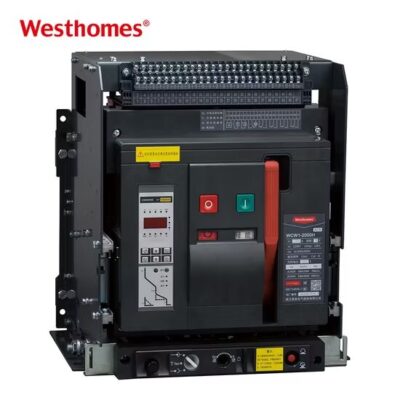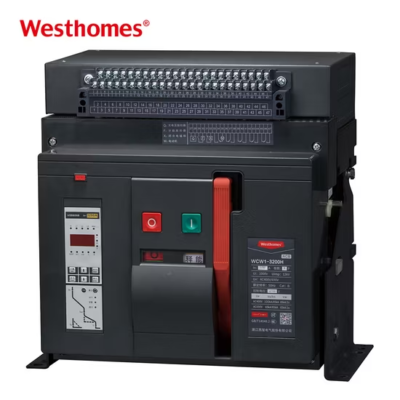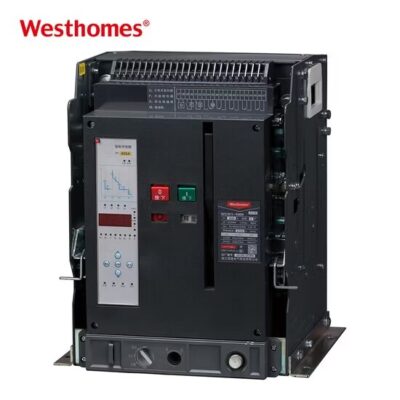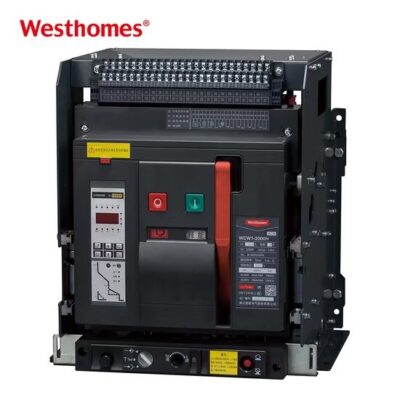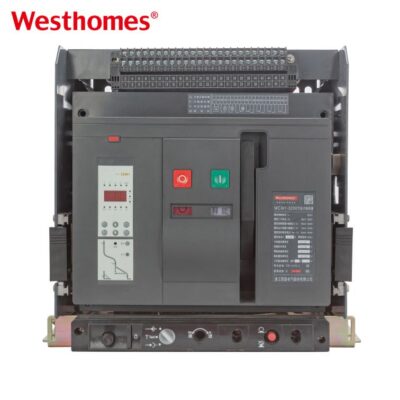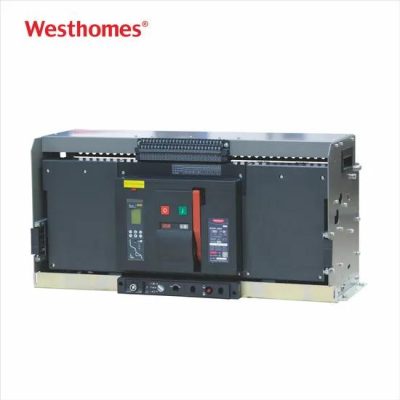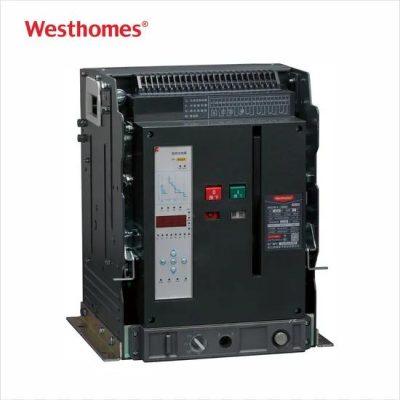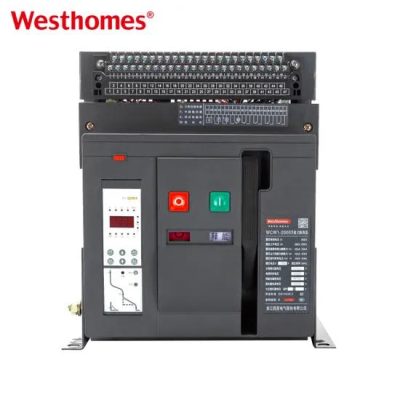Get quick appointment for technical support!
Advanced Air Circuit Breakers for Demanding Power Systems
An Air Circuit Breaker (ACB) is an automatic device designed to safely disconnect high electrical currents during abnormal conditions such as overloads or short circuits. It uses air as the arc-quenching medium, which makes it particularly suitable for low-voltage power distribution systems. ACBs are typically used in applications below 450V and are capable of handling currents ranging from 800A to 10,000A, providing essential protection for electrical infrastructure in industrial and commercial environments.
Westhomes’ Air Circuit Breakers deliver dependable protection and high performance across a wide range of power systems. From 630A to 6300A, with rated voltages up to AC690V and breaking capacities up to 120kA. Air circuit breakers are commonly used to power large equipment directly or serve as the main breaker in major switchboards. Backed by proven technology, our ACB solutions ensure the protection of people, assets, and operations across a wide range of critical environments.
Need help finding the perfect product or system?
No problem at all. Let one of our expert advisors point you in the right direction.
FAQ
How does an Air Circuit Breaker (ACB) work?
An Air Circuit Breaker (ACB) functions as a protective switch that safeguards electrical systems. During normal conditions, current flows through closed contacts. When a fault such as an overload or short circuit occurs, the ACB trips and the contacts open, creating an arc. This arc is extinguished using a blast of air, stopping the current flow and preventing damage. It works similarly to blowing out a flame to stop a potential fire.
What are the types of Air Circuit Breakers?
- Air Circuit Breakers come in several types, each suited for different electrical conditions:
- Plain Break (Cross-Blast) ACB: A basic design where the arc is broken in open air. Suitable for lower current applications.
- Magnetic Blowout ACB: Uses an electromagnetic field to deflect and lengthen the arc for quicker interruption.
- Air Chute ACB: Incorporates arc chute chambers to cool and divide the arc, improving quenching efficiency.
- Air Blast ACB: Applies high-pressure air to rapidly extinguish the arc. Ideal for fast and high-load operations.
What are the applications of Air Circuit Breakers?
Air Circuit Breakers are widely used in low-voltage systems and critical environments such as:
- Building electrical distribution: Protecting circuits in residential, commercial, and institutional buildings.
- Motor control and protection: Managing motor startup and safeguarding against faults in industrial settings.
- Power plant auxiliaries: Protecting support equipment within power generation facilities.
- Fire-sensitive or hazardous environments: Preferred in areas with fire risk due to non-flammable arc extinguishing.
- Frequent operation scenarios: Robust design makes them ideal for systems requiring regular switching.
- Industrial facilities and factories: ACBs are extensively used in factories and heavy industry to control and protect high-capacity loads, main switchboards, and essential machinery. With rated capacities from 630A to 6300A and breaking capacities up to 120kA, they ensure stable and safe operation in demanding conditions.
What are the benefits of Air Circuit Breakers?
Air Circuit Breakers offer several key advantages:
- Safety: Air is a clean and non-flammable arc-quenching medium, reducing fire risk.
- Fast operation: Quick fault interruption minimizes system damage and downtime.
- Low maintenance: Simple construction leads to easier inspection and fewer service requirements.
- Environmentally friendly: Air does not pose environmental hazards, unlike oil-based alternatives.
- Reliable performance: Long lifespan and consistent operation even under frequent switching or heavy loads.
What standards do Air Circuit Breakers comply with?
Most ACBs are manufactured according to international standards to ensure safety and compatibility:
- IEC 60947-2 (Low-voltage switchgear and controlgear – Circuit breakers)
- GB 14048.2 (Chinese national standard equivalent)
- UL 489 and ANSI standards for North American markets
What are the key components of an Air Circuit Breaker?
A typical ACB consists of the following components:
- Main contacts: Carry the normal load current
- Arc chute: Cools and extinguishes the arc during interruption
- Trip unit: Detects fault conditions and triggers the breaker
- Operating mechanism: Opens and closes the contacts
- Interlocking system: Ensures safe maintenance and operation
Modern ACBs may also include digital displays, communication modules, and programmable trip settings.
How is an Air Circuit Breaker installed and maintained?
Installation should follow manufacturer guidelines and local electrical codes. Key steps include:
- Mounting in switchgear or panel enclosures
- Connecting incoming and outgoing cables or busbars
- Setting trip parameters according to load requirements
- Verifying mechanical interlocks and protection logic
Routine maintenance includes visual inspection, testing of trip units, cleaning of arc chambers, and verifying contact wear. Compared to other breakers, ACBs are known for ease of maintenance and long service life.
How do I choose the right ACB for my factory or industrial system?
Selecting the right ACB for an industrial environment involves evaluating several factors:
- Rated current (In): Ensure the ACB covers the expected load range (e.g., 630A, 1600A, 3200A, etc.)
- Breaking capacity (Icu/Ics): Must meet or exceed the system’s short-circuit levels (e.g., 50kA, 65kA, 85kA, or 120kA)
- Installation type: Fixed-mounted or draw-out versions, depending on whether fast replacement or maintenance access is required
- Control interfaces: For smart factories, check if the ACB supports communication protocols (Modbus, Ethernet, etc.)
- Environmental conditions: Ensure compatibility with temperature, humidity, and vibration levels typical of your facility
If needed, Westhomes can provide technical consultations to help tailor the correct configuration for your application.
Can Air Circuit Breakers be customized for OEM or project-based applications?
Yes. For B2B customers such as OEMs, panel builders, and engineering contractors, Westhomes offers flexible customization options, including:
- Rated current and trip characteristics
- Panel cut-out or mounting compatibility
- Digital communication modules and remote monitoring
- Branding/labeling services for OEM integration
- Bulk supply agreements for project deployment or serialized manufacturing
Whether you’re designing switchboards, assembling factory automation cabinets, or supplying national infrastructure projects, our engineering team supports end-to-end ACB solutions that fit your technical and business needs.
REQUEST
YOUR FREE QUOTE
* indicates a required field
